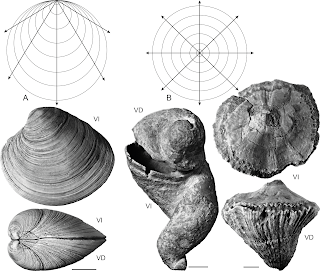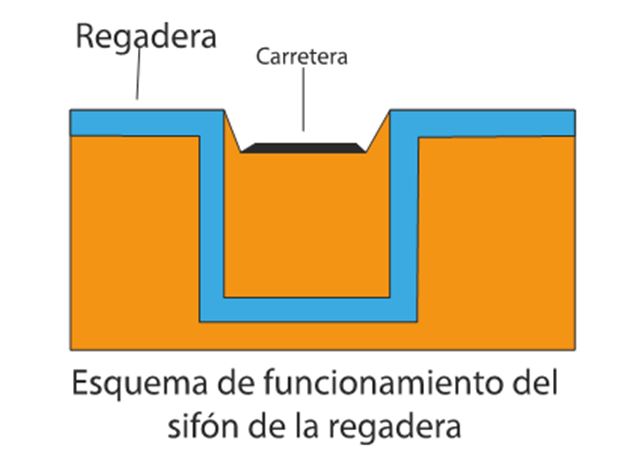ROUTE 1 WAYPOINT 8, ROUTE 2 WAYPOINT 4 AND ROUTE 3 WAYPOINT 4
Waypoint 8: The reef. (Map route 1) (Map route 2) (Map route 3)
We arrive at what it may be the most important waypoint of the route, the Sistine Chapel or the Sancta sanctorum of Castrojimeno Village.
Here we arrive at the reef itself, what corresponds to the facies C and D (already described previously), where we see the sucession of fossils that are substituted eventually, depending on the dynamic conditions, in particular Radiolites Sauvagesi, Hippurites Incisus that are really close which are substituted with clustering of Biradiolites angulosus, Radiolites Sauvagesi and Hippurites incisus.
As we have mentioned, this sucession is the reef itself in different zones of the barrier and with small variations generated of storms or the different positions that conform the barrier of the reef.
The most interesting parts of this point are not only the fossils, that present a perfect state of conservation, but also the detailed analysis of the suecssion of fossils and the strata that let us analyse in a small scale the variations of the sea level, in what we call 4th order cycles related with lower orbital periods. In fact, an analysis of the rudist may lead us to an interpretation of the oscilations in the sea level more specific.
R1.8a
At this point it starts to appear what we may consider as the most valuable geological element, at least from a scientific point of view.
It is a bioconstruction of rudists. It is necessary to point out that even though coloquially it is denominated as a reef, it is more rigorous to denominate reefs to the bioconstruction of coral.
A rudist its' shape and lifestyle is similar to corals. However, rudists are bivalve and corals have their own gender.
The main characteristic of rudists is their holoperipheral growth, they grow in all directions from the starting point (normally it happens with an angle of 60 degrees).
In Castrojimeno village the following rudist species are the most typical:
- Hippurites incisus: Characterized by their thiness and extended shape with two inner pillars really marked and a joint that can also be really marked.
- Biradiolites canalicatus: Also slim, with slightly thicker walls but without inner structures
-Radiolites sauvagesi: Characterized by a really thick and winding wall. Highlights the diferent sheets that form the shell.
-Praeradiolites Raequini: This species is the most different one because it maintains some growth in spiral.
-Vacinites giganteus: Its' main characteristic is it's big size. In case of Castrojimeno, usually isolated examples.
From: Pons, J.M. y Vicens, E. (2012) Los rudistas, objeto de interés paleontológico de la Dra. Alencaster Morfología constructiva de la concha de los rudistas. Paleontología mexicana 62. A. Crecimiento hemi-periférico.
R1.8b
Rudists form in Castrojimeno village a big formation similar to a reef. At this point we see how they group and how the different species occur what enables us to distinguish several units.
UNIT D: Here we again find 3 differentiated subunits.
I. Bouquet (clusters) of big size formed especially by Radiolites and lesser Hippurites. They are related to storms.
II. This unit is supported directly thanks to the first one. Its composed by clusters of Radiolites, Biradiolites and Hippurites (in a 15:2:3 proportion)
III. Again a very clised structure of clusters of Hippurites with some isolated Radiolites.
They are similarly interpreted as in unit C, an alternation of calm and stormy periods that truncate the growth of rudists, causing them a new start again.
UNIT C: Further on the sucession is more complex wuith 3 different units.
I. Radiolites Sauvagesi Cluster; Bouquet of Hippurites Incisus. Environment:Moderate foundations and stable conditions between different episodes of storms.
II. Bouquet of Hippurites Incisus with some Biradiolites angulosus and isolated Radiolites Sauvagesi. Enviroment: lower sedimentation and more stable with fewer stormy episodes.
III. Cluster abundant of Radiolites and Biradiolites even though there are some isolated Hippurites. Environment: More agitated with lower sediments generating a monospecific growth of Biradiolites.
UNIT B: Next we find a bioclastic unit, similar to the previous one but where we can start to see bigger fragments, we can highlight particuarly the fragments of Radiolites Sauvagesi and fewer Hippurites incisus. We can relate this rocks as very similar to the previous one but closer to the zone where rudist are in a living position.
UNIT A: It starts with some tempestites, in other words sediments formed in pewriods of more or less intesisty of storms. There are lots of fragments of radiolites (with Floatstone and rudstone structures), removed material with different content in the matrix.
1: Detail of the stratigraphic column of the second carbonatic abr. We can distinguish the different stratigraphic units.
Figure 2: Group of photographies of the reef:1- Unit A: Chalky rocks with fossil fragments.
2- Unit B: Detail of Radiolites sauvagesi and Hippurites incisus disperse in the matrix.
3- Unit C: Detail of the unit 1, with Hippurites incisus and radiolites sauvagesi.
4- General view of the reef.
5- Unit C: Detail of unit 2, with lots of Hippurites and Biradiolites.
6- Unit B: Detail of Radiolites in Hippurites.










Comentarios
Publicar un comentario